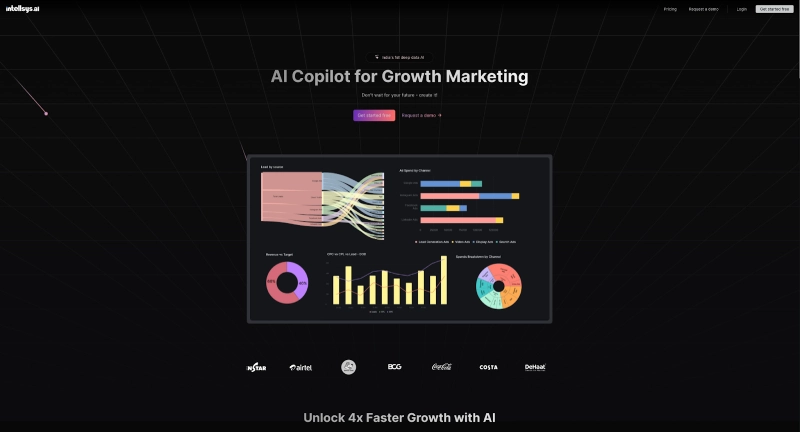Inside the Livguard AI Case Study: How GrowthJockey Built a Scalable AI Platform

What if your website didn’t just display products but actually thought with your customer?
That’s the shift Livguard made when they partnered with GrowthJockey. Known for powering batteries and energy solutions across India, Livguard had a bold ask. They wanted to turn a static product site into a smart, AI-powered platform that could drive real discovery, personalisation, and growth.
Enter GrowthJockey, a venture studio that builds scalable digital platforms for high-growth businesses. We rebuilt the Livguard website from the ground up, starting with a modular, scalable backend.
Then came the layers of intelligence: suggestive search, multilingual UX, and a dynamic AI recommendation engine that made browsing as intuitive as chatting.
In this Livguard AI case study, we’ll walk through how it all came together to form a future-ready AI platform for business, with measurable lifts in traffic, engagement, and speed.
If you're looking for real AI business ideas, this one’s worth dissecting.
How we set the stage for Livguard’s AI platform for business
Before we wrote a single line of code, we aligned with Livguard on what the website development needed to achieve, and it was one that was smart, scalable, and secure.
Every decision, from how users search to how the backend scales, was designed to position the Livguard website as a high-performing, intelligent AI platform for business.
Here’s how we broke down the mandate:
-
Build intuitive discovery: The goal was to make exploration effortless, so users could quickly find the right product, dealer, or support, without confusion or deep navigation. Given Livguard’s diverse audience across India, this meant designing an experience that worked seamlessly across languages, literacy levels, and device types.
-
Engineer horizontal scalability: The vision was to futureproof the platform for high-traffic spikes, product expansion, and rapid feature rollout. We needed a structure where new tools, modules, or experiences could be added independently, without slowing down the whole system.
-
Embed defensible security: Cybersecurity in the energy sector isn’t a checkbox; it is a non-negotiable. From user sessions to sensitive data, we had to ensure the platform could scale without introducing vulnerabilities or compliance risks.
Together, these goals laid the groundwork for transforming the Livguard website into a scalable, secure, and intelligent AI-powered platform.
Scalable by design: The tech foundation behind the Livguard AI case study
To support a growing product line, nationwide demand, and future AI integrations, the backend couldn’t be rigid. It had to evolve as fast as the business. Thereby making it fit not just for today but also for the next stage of Livguard's growth.
Here’s how this phase of the Livguard AI case study took shape:
Horizontal scaling and modular architecture
The foundation had to support rapid growth without rework. By building in horizontal scalability and isolating modules, we gave Livguard the ability to roll out new features independently.
Think product pages that update without crashing the homepage. Or adding an AI recommendation engine (called the Power Planner) that suggests the right inverter based on your room size, appliance mix, or usage pattern.
Whether it’s that, or a dealer-facing dashboard, this modular structure makes the Livguard platform flexible, fast, and ready to grow. That’s the kind of agility every AI platform for business needs to stay competitive.
Global performance plumbing
Speed is non-negotiable when your platform serves users across India, from high-speed metro zones to towns where mobile networks still drop. For Livguard, delays in page loads could mean lost leads, frustrated dealers, or customers dropping off before finding the right product.
So we implemented CDN distribution, which stores versions of the site on multiple servers across regions. That way, users get lightning-fast load times no matter where they’re browsing from.
Add to that aggressive caching, and the result is a smoother, more reliable experience across the board.
Compatible like never before
Livguard’s ecosystem spans dealers, service requests, support, calculators, and content, with each needing different capabilities. A single monolithic stack would slow shipping and limit flexibility.
So we used a multi-stack approach: a CMS for content, and dynamic front-end components built with user interface best practices in mind. We also added service layers and microservices for calculators and integrations, with all pieces connected via APIs so updates happen independently without breaking the site.
The result was an agile backbone for this digital transformation case study, and headroom for future AI business ideas.
This architecture gave Livguard more than just performance gains; it created a flexible, AI-ready backbone built for rapid evolution. Every technical decision here feeds directly into the business outcomes that define this Livguard AI case study.
How intelligent UX fuels performance in the Livguard AI case study
Obviously, we couldn't stop at just scaling the platform.
If the backend was the engine, the user experience had to be the driver: clear, responsive, and built for action.
Every interaction needed to feel natural, useful, and fast, whether someone was comparing batteries or moving through the AI-powered buyer journey designed to find the right dealer.
Here’s how we turned those goals into reality:
-
Suggestive search and on-the-fly wayfinding: Users can just start typing to instantly jump to product categories, blog posts, or support pages, removing clicks, menus, and guesswork.
-
LivBot + Dealer Locator = always-on support: From 24/7 assistance via Smart Connect to instant dealer mapping through PIN or city search, users are never more than a tap away from help or a point of contact.
-
Multilingual + dark/light UX for real accessibility: Livguard introduced India’s first Hindi website for inverters, along with a dark mode toggle to reduce eye strain and boost usability across devices. Critical for reaching India’s diverse user base and scaling a truly inclusive B2B website in India.
-
Desktop-grade experience: Fully optimised desktop views with component-specific rendering ensure rich, scroll-efficient UX. This is especially important for comparison-heavy journeys, where buyers evaluate specs, prices, or variants side by side before making a decision.
-
Security stack: From session protection and encrypted data to regular patching and clean code practices, security was engineered at every layer. It’s the kind of foundation every scalable AI platform for business needs.
Together, these features made the Livguard website feel less like a catalogue and more like a guided, intelligent experience.
Want to go deeper into how platforms can drive long-term engagement beyond the first click? Check out our blog on customer lifecycle strategies for actionable ideas your team can use.
Laying the groundwork for real AI integration in the Livguard AI case study
Great UX solves for today. But what if the platform could also learn from user behaviour, predict intent, and keep improving without major rewrites?
That's the leap we designed for, moving from a functional website to a foundation that can support intelligent automation, personalisation, and inference at scale.
Let’s take a look at what makes the Livguard platform truly AI-ready:
-
AI-ready data flows with Power Planner at the core: Unlike one-time calculators, the Power Planner was designed to evolve. Its structured inputs, user patterns, and product logic can feed future AI/ML models for business growth without a full rebuild.
-
Modular tech stack for plug-and-play intelligence: The platform can absorb inference engines, analytics layers, or personalisation tools as independent services. Hence, making it easy to test, refine, or replace logic without affecting site stability.
-
Signals for personalisation already in place: From language preference and location-based dealer maps to LivBot chats and product searches, the site already collects rich behaviour data. Which, in turn, AI can use in the future for better targeting and decision-making.
Powering this foundation was Intellsys - our internal automation and AI stack. We used it to map behaviour patterns, structure data inputs, and ensure the site could evolve into an adaptive system.

This makes it a true mark of this website being future-facing. Livguard now has the systems, signals, and structure in place to evolve into an AI platform for business.
Turning architecture into impact: Results from the Livguard AI case study
Now that we’ve unpacked how we built the platform, let’s talk about what it actually achieved. Since a smart architecture isn’t enough if it doesn’t translate into visibility, performance, and user engagement.
Here are the five most impactful outcomes that solidify this build as a true digital transformation case study:
-
7.6× increase in daily page views (from 2,982 to 24,885): A direct outcome of faster load times, better discovery, and smarter UX pathways, proving that a scalable experience drives scalable traffic.
-
38% faster Time to Interactive (6.7s → 3.1s): Shaving seconds off wait time means faster journeys and fewer drop-offs.
-
84% reduction in total page size (4.20MB → 1.91MB): A lighter platform translates into better performance across devices and geographies, making this a future-ready AI platform for business.
-
Up to 4× longer session times on key templates: Pages like the Power Planner and Dealer Locator now see engagement times as high as 4+ minutes with bounce rates as low as 21%, signs of high-value, goal-completing visits.
-
SEO score jumped from 62% to 84% (GTmetrix): Improved structure, accessibility, and speed helped the platform become more discoverable.
To make this even clearer, here’s a quick snapshot of the most relevant metrics from the Livguard AI case study:
| Metric | Before | After | Change |
|---|---|---|---|
| Daily Page Views | 2,982 | 24,885 | 7.6× increase |
| Time to Interactive | 6.7 seconds | 3.1 seconds | 38% faster |
| Total Page Size | 4.20 MB | 1.91 MB | 84% reduction |
| Session Time on Key Pages | ~1 min avg | 4+ mins (select pages) | ~4× increase |
| SEO Score (GTmetrix) | 62% | 84% | +22 points |
What the Livguard AI case study proves for enterprise teams
This project was about more than visuals or surface-level UX. It focused on building a system that could move faster, scale smarter, and support real business growth, with AI-readiness baked in from day one.
If you're leading a digital product or platform revamp, here are a few takeaways from this digital transformation case study worth keeping in your back pocket:
-
Prioritise UX features that reduce friction at scale: Start with search, language flexibility, and guided flows; these are the building blocks of long-term engagement and smarter decision-making.
-
Build modular from the start: Structure your backend so you can launch, test, and replace features independently. It’ll save you months down the line when scaling or experimenting with AI business ideas.
-
Don’t bolt on security, bake it in: From session handling to encrypted data and safe code practices, build security into your stack early. It’s a must for any future-ready AI platform for business.
Quick tip for your team:
If you're thinking, "We’re not ready for AI yet, should we still build this way?"
The answer is yes.
Designing for scale, speed, and clean data flows now means you won’t need to rebuild later when AI does become a priority. It’s future-proofing your tech stack without overcommitting upfront.
What this transformation means for your next platform build
Livguard didn’t need a prettier website; they needed a platform that could keep pace with how fast the business was evolving. This build brought that to life. A modular backend, intelligent UX, and model-ready systems came together to create something that’s not just built for today, but built to grow.
That’s why this Livguard AI case study matters. It shows what a real platform for business looks like in action: stable under load, easy to expand, and ready to plug into future systems.
If that’s what you’re solving for, you don’t need an agency.
You need a partner who can think across product, growth, and speed.
Exactly, what we do at GrowthJockey, as your embedded business accelerator, co-builder, and long-term launch team.
FAQ’s on Livguard as a b2b website in India
What is an example of AI in a case study?
In the Livguard AI case study, AI was built into the platform through the Power Planner: a smart recommendation engine that suggests the right battery or inverter based on user inputs.
This feature turned a static catalogue into an AI-powered platform with real decision support, improving both conversions and user experience.
How is AI used in B2B?
In B2B platforms, AI is often used for lead scoring, dynamic content personalisation, intelligent search, and product recommendations. An effective AI platform for business helps streamline the buyer journey and scale operations without adding manual overhead.
Will AI replace B2B sales?
AI won’t replace B2B sales; rather, it’ll enhance them. From chat-based product advisors to automated nurture flows, AI enables faster, smarter decision-making. The key is building systems that support this technology, not replace the human strategy behind complex sales.
What is the future of B2B marketing?
The future is platform-led, insight-driven, and scalable. So, think: AI business ideas that fuel personalisation, predictive content, and real-time engagement. B2B brands that invest in modular, intelligent systems will lead the next wave of growth and not just stop at generating leads.








